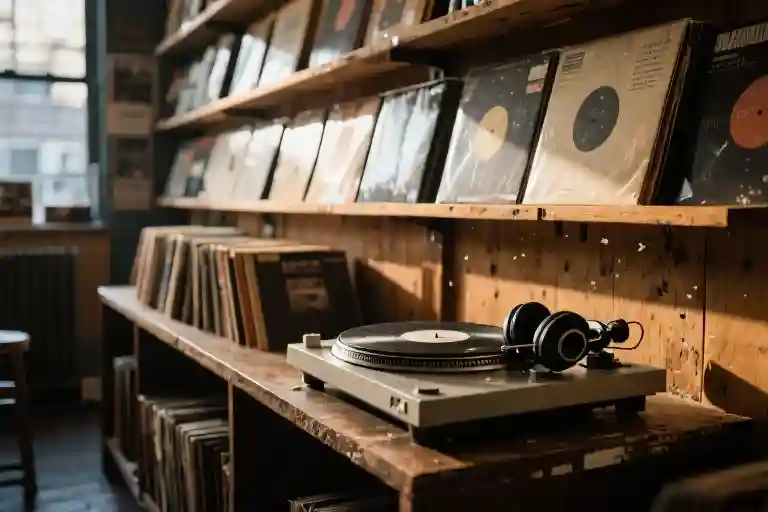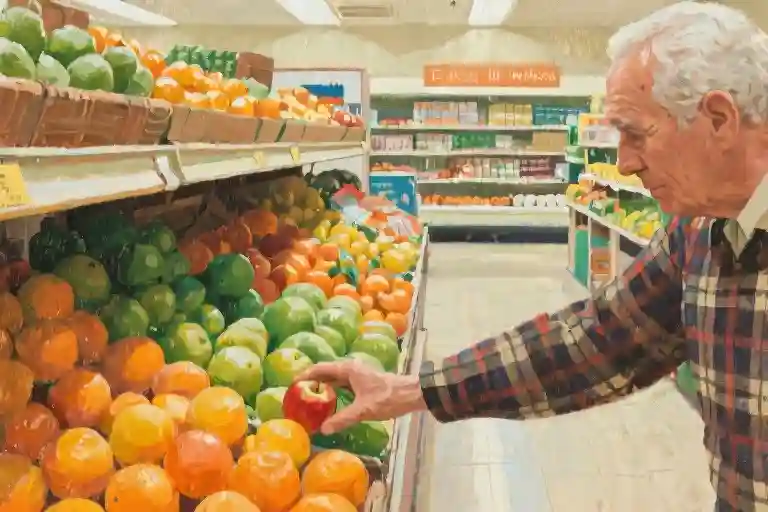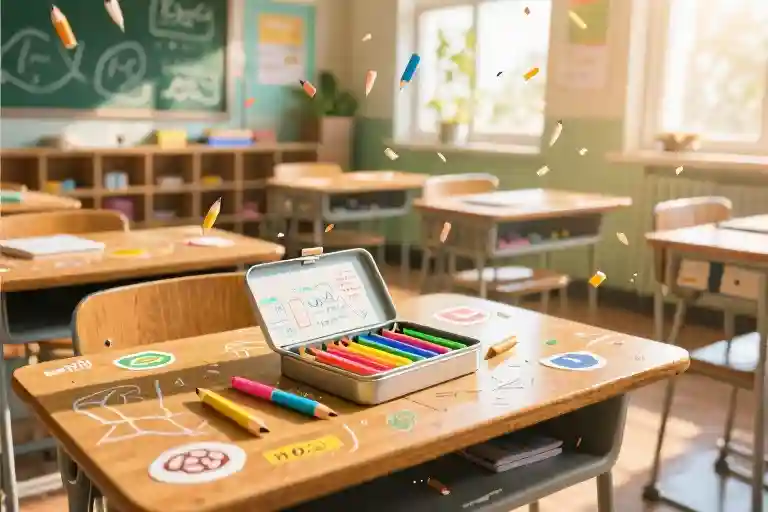The record store smelled of dust and decades, its narrow aisles barely accommodating two people at once. Fading album covers lined the walls like artifacts in a museum of forgotten sounds. Three of us moved through the space with the careful choreography of strangers avoiding contact – two men methodically flipping through vinyl stacks, their backs forming perfect right angles to the counter where the owner leaned, absently wiping a record sleeve with his sleeve.
Light filtered through the front window at an angle that highlighted floating particles more than merchandise. The place couldn’t have been more than three hundred square feet, yet it contained entire lifetimes of music. That peculiar quiet of record stores settled over us, the kind where the absence of background music feels louder than any playlist.
‘Don’t know how to meet women anymore,’ the owner said suddenly, his voice cutting through the vinyl-sleeve rustling. He didn’t look up from the record he was cleaning. ‘By closing time, I just want to feed the dogs, maybe fix something at home. No energy left for bars or whatever places people go now.’
His gesture took in the cramped store, the two oblivious customers, the racks of alphabetized longing. I understood without him explaining further. The ritual here was solitary – fingers tracing spines, eyes scanning track listings, the occasional soft exhalation when finding a coveted pressing. Not exactly fertile ground for connection.
‘There was this one woman…’ he continued, and the story unfolded with the familiar rhythm of near misses and bad timing. Life got complicated, circumstances intervened, and when things finally settled, she’d moved to Tennessee.
‘Which part?’ I asked.
The needle lifted from some unheard record in the back room, punctuating the silence that followed.
The record store smelled of dust and decades, the kind of place where time didn’t move forward so much as circle back on itself. Three of us occupied the space that day—two strangers with their spines turned to each other like opposing magnets, fingers tracing the edges of vinyl sleeves with the devotion of archaeologists brushing sand from artifacts. Between the racks, the owner leaned against the counter, absently polishing the same spot on a Joan Baez album cover with his shirtsleeve.
‘I’m not sure how to meet women anymore,’ he said. The words hung between us, unexpected but not entirely surprising in this basement-sized temple to nostalgia. His voice carried the same static crackle as the vintage speakers humming behind him.
Outside, the city pulsed with dating apps and speed-meet events, but here among the alphabetized memories, courtship had become as obsolete as 8-tracks. The other customers never turned from their digging—one crouched in the Jazz section, another methodically working through the Ps. Their silence felt heavier than the stacks of records surrounding us.
‘By the time I close up,’ the owner continued, eyes still on that smudge that wouldn’t disappear, ‘I just want to walk my dogs, maybe fix that loose step on my porch.’ His thumb paused mid-circle. ‘The idea of going somewhere new to make conversation…’ The sentence dissolved into a shrug that said more than the words it replaced.
I watched a customer pull a record from its sleeve, holding it up to the dim light to inspect for scratches. His lips moved silently along with some internal rhythm, a private communion with the past. The owner followed my gaze.
‘Not exactly a singles crowd we get here,’ he said, and the laugh lines around his eyes didn’t quite reach his actual expression. Behind him, a neon ‘OPEN’ sign buzzed like an insect trapped against glass. The two searchers continued their methodical hunting—one for a rare pressing, the other perhaps just for the comfort of the search itself. We all have our versions of digging through the past, hoping to find something we can hold in our hands.
The Owner’s Confession
The record store owner leaned against the glass counter, fingers absently tracing its chipped edge. His admission hung between us like the dust motes floating in the afternoon light. “By the time I close up here,” he said, eyes fixed on some distant point beyond the rows of vinyl, “all I want is my dogs’ company and the quiet of my toolshed. The idea of going out to meet someone feels like running another shift after overtime.”
His hands moved as he spoke, performing a tired ballet of habitual motions – straightening already-aligned price tags, nudging a stack of plastic sleeves into perfect perpendicularity. Each gesture seemed to underline his words. Here was a man who had mastered the art of maintaining objects but found human connections slipping through his fingers like grains of sand.
“There was a woman once…” The sentence trailed off into the space where most middle-aged stories of missed connections begin. The pause that followed wasn’t empty but crowded with the ghosts of possibilities. When he continued, it was with the careful detachment of someone describing a dream half-remembered upon waking. A coffee date postponed by a family emergency, a rescheduled meeting that never happened, until one day her social media showed Tennessee skies behind her profile picture.
“What part of Tennessee?” I asked, more out of reflex than real curiosity. The question barely registered before dissolving into the hum of the overhead fluorescent lights. Geography hardly mattered when the real distance was measured in elapsed time and expired opportunities.
Around us, the other customers moved through their private rituals of browsing. One man examined the same Beatles album for the third time, his thumb worrying at a corner of the sleeve. Another stood frozen before the Jazz section, paralyzed by some internal calculus of desire versus disposable income. Their presence underscored the store owner’s dilemma – this was a temple of solitary pleasures, not spontaneous connections. The very things that made the space comforting (the predictable alphabetization of artists, the ritualistic flipping through racks) also made it sterile ground for human chemistry.
He wiped the counter with a cloth that simply redistributed the dust. “At my age, you start doing the math,” he said. “The energy required to build something new versus the comfort of what you’ve already built.” His eyes flicked to a framed concert poster on the wall – some legendary show from decades past when both the band and he had more hair and less arthritis. The poster’s edges had yellowed behind the glass, preserving a moment that grew more distant with each passing year.
The Tangible Substitute
Fingers tracing the grooves of a record sleeve make a particular sound—that soft rasp of skin against cardboard, like a whispered secret. In the dim light of the store, I watched the owner handle a 1973 pressing with the care of someone touching a lover’s face. His thumb brushed across the surface, checking for imperfections, while his eyes stayed fixed on some middle distance beyond the shop walls.
This ritual of inspection felt heavier than simple commerce. Each record in his hands became more than vinyl and ink; it transformed into something solid to hold when human connection proved too slippery. The physicality of the object offered what modern dating couldn’t—clear grading standards (Near Mint, Very Good, Fair), definite borders, no sudden disappearances after three dates. You could assess a record’s flaws under a lightbulb, while people’s damages only revealed themselves over months, often at the worst possible moment.
Across the room, a regular customer methodically worked through the jazz section, his movements precise as a surgeon. I’d seen him before—always hunting for specific Blue Note pressings, rejecting reissues with a barely perceptible shake of his head. His pursuit mirrored online dating profiles I’d encountered: seeking original, not remastered; authentic, no reproductions. Yet here, the parameters felt honest. A record either had the right deadwax inscriptions or it didn’t; people carried their hidden track listings in ways no dating app questionnaire could uncover.
The owner slid the record back into its sleeve with practiced ease. ‘At least when they’re scratched,’ he said, not looking up, ‘you can hear it right away.’ His voice carried the weight of someone who’d learned to measure disappointment in decibels rather than silent treatments. The pop and hiss of a damaged groove became preferable to the mute button applied to modern ghosting.
We pretend these objects we collect are about the music, but the truth hums beneath like a properly grounded turntable. They’re talismans against uncertainty—finite, knowable things in a world where connections increasingly resemble bad Bluetooth signals, cutting out at crucial moments. That original 1965 pressing won’t suddenly decide it’s not in the mood tonight. The 180-gram reissue won’t leave you on read for three days then reappear with excuses about being ‘bad at texting.’
The store’s bell jingled as another customer entered, shoulders already hunched in the universal posture of someone bracing against disappointment. His eyes went straight to the psych rock section, fingers twitching toward the familiar comfort of categorization. I wondered which heartbreaks each of us was trying to outmaneuver through this careful curation of plastic and paper. The records would never love us back, and maybe that was precisely why we kept coming.
The Grading System of Scratches
The record store’s lighting caught the dust motes in suspension, each particle hovering like a misplaced note in an otherwise perfect recording. Near the counter, a customer held a vinyl up to the fluorescent tubes, squinting at its surface with the intensity of a cardiologist reading an EKG. ‘VG+,’ he muttered, placing it back in the crate with the resigned sigh of someone who’d seen too many almost-rights in life.
This was how we measured damage here – not in emotional terms, but through the precise taxonomy of the Record Grading Scale. Near Mint (NM) for the untouched, Very Good Plus (VG+) for the slightly wounded, Fair/Poor (F/P) for the battle-scarred survivors. The parallels were uncomfortable. Most of us fell somewhere between VG and VG+, carrying scratches that didn’t affect playability but showed up under certain light.
The owner wiped a sleeve across an album cover absentmindedly. ‘Funny thing,’ he said, ‘collectors will pay extra for original pressings with all their flaws, but try bringing your personal baggage to a first date.’ His laugh got caught somewhere between bitterness and amusement, the audio equivalent of a needle skipping on a stressed groove.
Two aisles over, a regular we called ‘1976 Guy’ methodically worked through the bins. He only collected releases from that single year, a self-imposed limitation that somehow expanded his world. There was safety in these parameters – no messy emotional improvisations, just the clean mathematics of catalog numbers and matrix runouts. His pursuit had the comforting illusion of completion: acquire all 1976 releases in this store, then the next, until… what? The universe contains multitudes, but record store basements contain more.
The grading scale betrayed us. Records could be cleaned, sleeves replaced, inner liners upgraded. Our personal scratches lingered in ways the Goldmine Standard couldn’t quantify – the ex who left a stylus-shaped dent in your ribcage, the missed connections that hissed like untracked surface noise. We developed coping mechanisms as elaborate as any audio restoration technique: the careful equalization of expectations, the noise reduction of selective memory, the endless searching for that one elusive pressing that would make the heart’s tracking force just right.
A woman entered, the first today who wasn’t here for the records. She asked about Bluetooth speakers, and the whole store tensed like a tonearm sensing the runout groove. The owner directed her to an electronics shop three blocks away with the relieved briskness of someone avoiding an awkward conversation. When the door chimed shut behind her, 1976 Guy exhaled audibly and returned to his systematic searching, fingers moving with the certainty they’d never possess in any dating app interface.
The records at least came with labels. Side A always led to Side B, the runout grooves whispered secret messages in the dead wax, and even the scratches told stories in their predictable patterns. Human connections offered no such linearity, no guarantee that the emotional investment would yield audible returns. We kept grading, kept searching, because the alternative was silence.
The Tennessee That Never Was
The record store owner’s voice trailed off when he mentioned Tennessee. It wasn’t just a geographical location anymore—it had become the physical manifestation of missed connections and roads not taken. That single word carried more weight than the entire stack of vintage vinyl separating us at the counter.
“What part of Tennessee?” I’d asked, more out of conversational reflex than genuine curiosity. The question hung between us like a needle suspended above a spinning record, neither touching down nor retreating completely. He never answered. Some destinations remain forever unspecified in our personal geographies, their coordinates blurred by time and what-ifs.
In the silence that followed, the shop’s ambient sounds grew more pronounced—the faint hiss of plastic sleeves being slid off jackets, the occasional click of a fingernail against vinyl grooves. Two customers still stood with their backs to us, their shoulders hunched in identical postures of quiet searching. We were all collectors here, in our way. The difference was their treasures could be alphabetized and priced, while ours remained uncatalogued.
The stylus lifted from our conversation with the same finality as the tonearm returning to its rest at the end of a side. No satisfying crescendo, no fade-out—just the mechanical click of an interaction ending where it had to. Outside, the city continued its indifferent movement. Someone somewhere was probably playing a perfect copy of Blood on the Tracks, while here we stood among the scratch-and-dent specials of human connection.
That’s the thing about record stores and missed chances—they both deal in gradations of imperfection. VG+ might be the best you can hope for when it comes to secondhand finds and second chances. The mint condition ones either don’t exist or get priced beyond reach. And Tennessee? It’s just the label we give to that unplayed B-side of our lives, the track we’ll never hear because we were too busy flipping through the bins of daily survival to notice when the needle reached the run-out groove.





